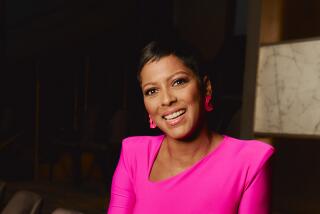‘She Said, He Said’: A Real Talk Show
- Share via
Anyone who ever has started an ordinary conversation with a member of the opposite sex only to end up considering the rewards of life in a monastery should find his or herself nodding in agreement to “She Said, He Said,” a public-television special being shown Wednesday at 9:30 p.m. on KOCE, Channel 50.
It spends about an hour (not counting three pledge breaks) with Deborah Tannen, a Georgetown University linguistics professor and author of the recent bestsellers “You Just Don’t Understand” and “That’s Not What I Meant.” Tannen’s tomes are self-help guides for better interpersonal relationships, based on scholarly research into the differences between male and female patterns of communication.
The program’s format seems a bit contrived at times--host Steve Roberts (who’s not identified beyond that) and members of the audience ask questions that lead almost too neatly into major issues addressed in Tannen’s books. But Tannen nevertheless proves to be an engaging speaker (But then, if she weren’t, she’d probably have to turn in her key to the Executive Linguists’ washroom.).
Her basic generalizations are that women use conversation to establish rapport and intimacy, where men communicate largely to exchange information and establish independence. Women often initiate dialogue just to be heard; men are obsessed with providing answers, even when none are sought.
Can such revelations be used to solve age-old complaints about women who nag and men who never listen? Oh, that’s such a typical male problem-solving sort of question. Tannen’s reply: By understanding what the opposite sex is looking for through conversation, we can help improve those communications.
One of the most intriguing parts of the show examines same-sex conversations among three groups of children--two boys and two girls in each, at the ages of 5, 10 and 15. The videotaped sessions show the same patterns at each age level: The girls face each other and maintain almost constant eye contact, while the boys sit more side by side, hardly ever looking directly at each other regardless of the subjects they are discussing.
Tannen outlines how these and other patterns of communication established during childhood carry over into adult opposite-sex relationships, and how they can produce the miscues, gaffes and knockdown drag-outs that most couples struggle to overcome. Here’s one male who would have liked to have seen more such examples of actual conversation and a little less talking-heads analysis of general conversational patterns.
It’s all delivered in what probably is as evenhanded a manner as possible, with Tannen doing her best to reinforce her message that neither the male nor female style is right or good, wrong or bad. If she has a solution to offer, it’s that we’ll all be better off if we don’t blame one another for communicating differently.
To this viewer, however, the scales seemed to tip slightly toward the conclusion that the world would be a better place if only men would lighten up and not be so, well, male about everything. Wait, I didn’t mean it to sound like that . . .


